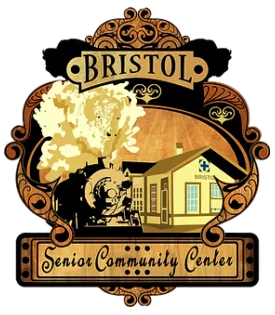Bristol History
Bristol History
Founding
The town of Bristol is located on a homestead which was settled in 1887 by George Stabe. The land was under the Amity Canal in 1889 and shares were sold for $10 each, the water to be used from sunup to sundown. If you wanted 24 hours of water, it took two shares per acre. The land was proved up by Stabe by December 31, 1890. It was located north of Granada in what was referred to as ‘the Haven neighborhood’ after a family of that name who lived in the area.
By 1893 the homestead, like many others in that hard time, was $19.01 delinquent in taxes and was sold to Mr. Cornett. It was broken up and changed hands several time until a part of the homestead was bought at a tax sale by a widow, Mrs. Mary Dugger from F. S. Butcher for $70.60 in the early 1900’s. The area was already well-settled because of the Amity Canal and the agriculture industry connected with it.
A business district was started when J. R. Gordon opened a hardware store and hotel in 1902. The primary clients of the hotel were traveling salesmen who used it as a center of business with the surrounding farms. The hotel had twelve small rooms, and the lobby was also part dining room and kitchen. It was made of the same brick (stone locally quarried) as the Bristol United Presbyterian Church. Two double-seater outhouses stood in the yard.
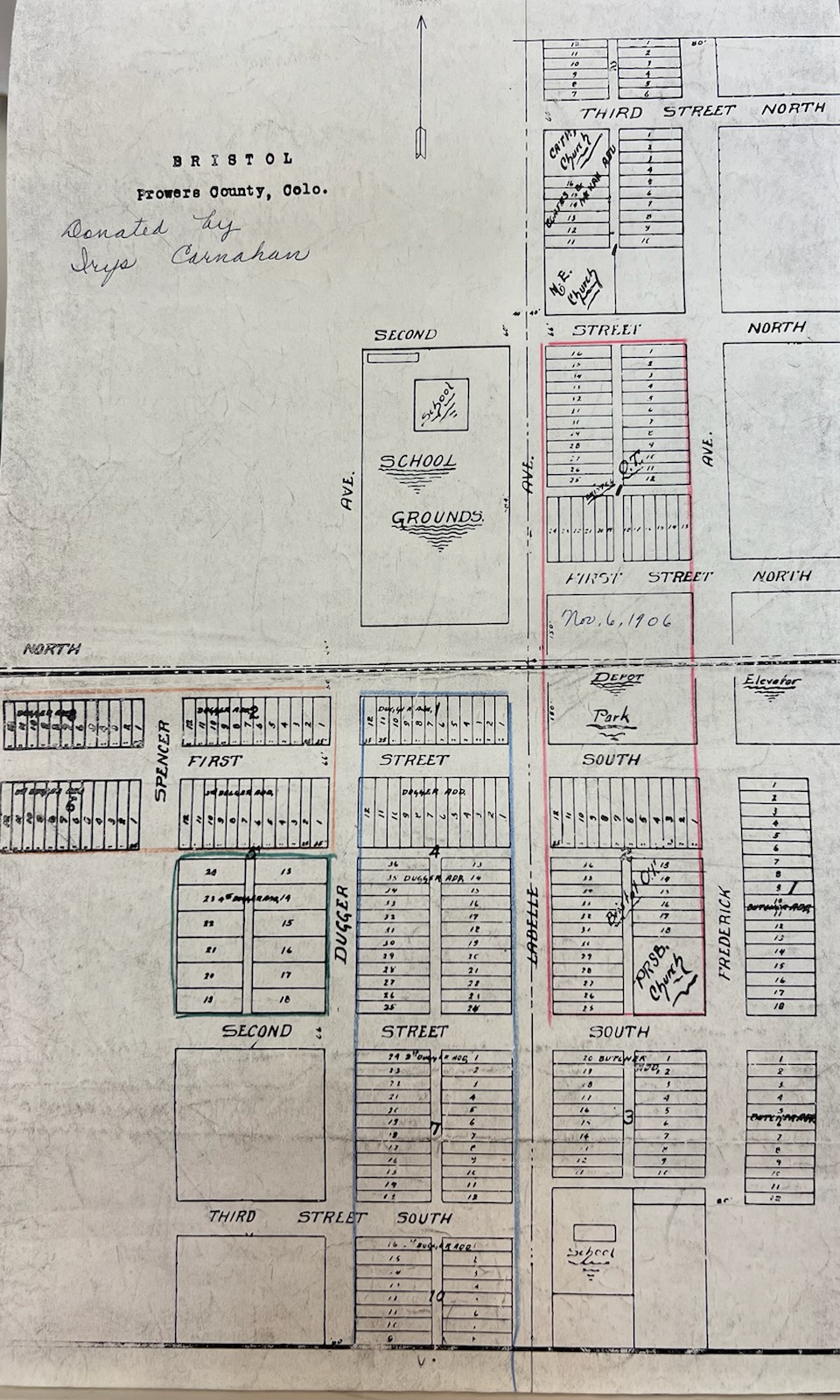
The plat of the town was filed on November 6, 1906 and F. S. Butcher is credited with helping Dugger establish the town, which, like many others of its era, was named after one of the chief officials of the Santa Fe Railroad, C. H. Bristol, assistant general manager of the A. T. & S. F. stationed in La Junta. C. H. Bristol owned land in the vicinity of Hartman, and the town of Bristol was originally to be called Hartman after George Hartman, who owned land near Bristol. However, a records mix up in the Chicago office of the Santa Fe railroad led the stations at those two points to be misnamed, and the towns followed suit.
Though the town had never been incorporated, it was once a thriving center for the farming community north of Granada, boasting an opera house and a pickle cannery, among other businesses. Apparently, the founders labored under no delusions that their efforts would result in a major metropolis, for the plat consisted of two blocks: one block on either side of a road named First Street, which straddled the survey line running east and west where the Arkansas Valley Railroad line would run. In the same year as the town was platted, Dugger gave land for the railroad right-of-way, which reached Bristol from Holly in September of that year. The line remained a local branch line throughout 1907, then in 1908 a connection between Bristol and Kornman completed the circuit of the Arkansas Valley District. Bristol was listed as milepost 13.1 in the Ark Valley District, and had a station and a small yard.
Between 1902 and 1914 several other businesses joined Gordon’s Hardware and the hotel. The first post office was located in Mrs. Duggers’s house in the south part of town. The first bank in town operated out of one of the hotel rooms. A man named Waterbury built a store at the east end of the First Street Block – the west end had the hotel at the corner and the hardware store next to it. Soon J. B. Nichol’s lumber yard sprang up across the street to the west of the hotel. Nichol also has a magnificent two-story white frame house – a stand-out on the treeless plain that was early Bristol. A little south of Nichol, the more modest one-story B. J. White house was located, about a block north of where the railroad tracks were laid. A railroad station went in across from the First Street business block when the railroad came through in 1908. Other businesses which sprang up included Hazel Feed Store, just east of Gordon Hardware, owned by an ex-sailor who had a parrot – between them they knew all the bad words in or out of a dictionary (kids gave that store a wide detour, Iris Carnahan notes); east of the feed store was the pool hall: then the printing office, home of the Bristol Herald; the post office which replaced Mrs. Dugger’s house as a mail drop; a barber shop; and, just west of Waterberry’s, Johnson and White General Store – which included a grocery, dry goods, hardware and mortuary. In those days the undertaker didn’t embalm. The hearse was drawn by James E. Bowen’s horses. The town also had a roller-skating rink.
Bristol History
Industry
The Bristol telephone system was to the Granada system – Mamie Woodcock of Granada was switchboard operator in 1910, according to the Colorado Telephone Directory. In 1912, Bristol was given a new switch board and Granada was served through that board. By 1918 Bristol had 64 subscribers and Granada had 43.
Spurred by the addition of the railroad and a burgeoning farm community, the town found it necessary to add to the modest dimensions first platted for its business district. Between 1911 and 1916 Labelle Avenue (Highway 385) acquired Deckers Realty; Wood’s Garage; a theater; a telephone office; Caddick Blacksmith Shop; The Bristol Mercantile Store which had living quarters above it, owned by the J. A. Rosebroughs, parents of Vernon and Vera Rosebrough; the Bristol State Bank; Coates & Moran Realty; Osterman’s Grocery and Dry Goods; and the W. Henry Chaplin Garage. George Osterman bought the Johnson and White grocery and dry goods stock in 1916, and in 1918 he bought a building facing Main Street, moved the stock, and opened a general store.
Jo Caddick, the blacksmith, built Bristol’s first school bus – a covered spring wagon with iron rims, horse drawn. The Allison boys, northeast of town, drove the bus to school, picking up children along the way. The first school house was a frame two-room building in the south part of town, approximately at Third Street and Labelle. Later the site became part of Durham’s Hog Yard.
To make room for the expanding business district, additions were made to the town, starting with Dugger’s Addition on May 28, 1909, named after Mary Dugger, owner of the tract; then Butcher’s Addition after Frank S. Butcher in 1910; followed by Coates and Moran’s Addition after Howard Coates and H. L. Moran on May 6, 1912.
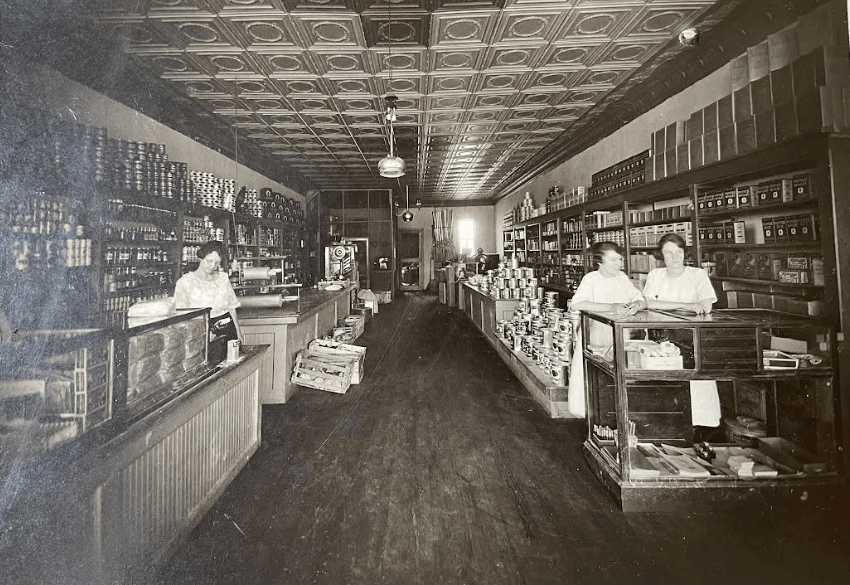
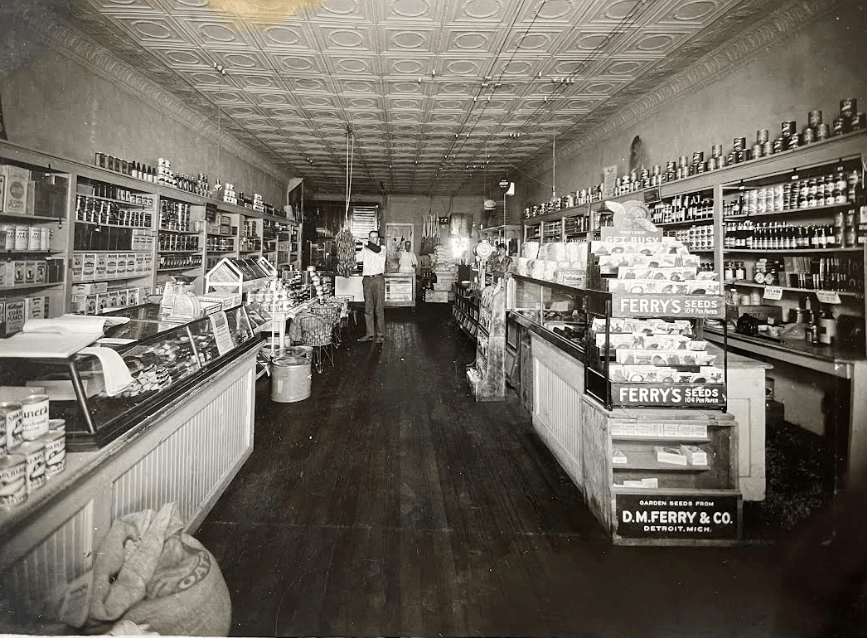
One early resident was Kansas-born Bert E. Sterrett, who came to Prowers County as a teenager in 1901 and took farm work with the G. Silverberger family southeast of Bristol. He was so young, Mrs. Silverberger took him under her wing, referring to him as “my boy, Bert.” He worked as timekeeper on the Ft. Lyon Canal construction crew, was drover and cook’s helper on a cattle drive and eventually acquired cattle of his own, which he ran on open range from north of Bristol to Missouri-Pacific rails.
While working at Rosebrough’s, he married Frances Dugger, sister of Roscoe Dugger and Mrs. Walter (Della) Decker. Frances and their son died during childbirth and in 1913 he married Esther R. Bowen of the Goodale Community west of Bristol. They had two daughters, Mrs. Brice (Helen) Gordon and Mrs. Frank (Erma) Smartt.
Neighbors of Bert in those early Bristol years were Will Silliman of Towner, John Morse of Sand Creek, Bob McGrath, Sam Porterfield, the A. N. Parrishes, and Hinton Hunter, all later of Lamar, George Bigenwalt, and Walter and Pearl Morris of Granada.
In 1910, Bert, along with Andy and Frank Puntenny and Art Mitchell and others, helped in the construction of the Bristol United Presbyterian Church where Esther was a pianist. He also served on both the Bristol and Granada School Boards, and as a rancher, he was the first to build a silo in the area. One of his prized possessions was a set of longhorns from an Old Mexico steer which jumped the stockyards fence three times before charging Bert – a stunt which the longhorn steer obviously did not live to regret. Bert and a Mr. Young, grandfather of Elmer, Louis and Marvin Brase, imported a stallion, named Hipolite, from France at a cost of $1,600 for breeding purposes and later sold him to Silliman. Sterrett was also director for the Southeast Colorado Livestock Show when it was first held in Lamar. He raised purebred Duroc hogs, which not only brought him prizes, but made him a nationally-known supplier, and perhaps internationally-known, as the Bristol Herald notes he received inquiries from South America concerning his hogs.
Esther was no slouch in the livestock industry herself. A turkey-raiser, she became president of the Southeast Colorado Turkey Club. Her Rhode Island Red chickens and their eggs also top prize winners at the Lamar Livestock and Poultry Shows.
Bristol History
Religion
Bristol’s three churches still serving congregations are the Bristol United Methodist Church, dedicated June 13, 1909; the United Presbyterian Church, dedicated April 2, 1910, and the Catholic Church.
Before Bristol was founded, church meetings were being held in the Buffalo School House and Bible school was being held at the Bristol School House north of Granada. In 1907, seventeen prospective church members petitioned the Presbyterian hierarchy for a church organization and in 1908, Reverend J. C. Lynn was assigned to the area as a missionary. January 27, 1909, with 30 charter members, the Bristol United Presbyterian congregation officially organized. Many of the new members had to travel long distances to get to church – the F. H. Puntenny family, for instance, drove (and these were horse and buggy days) from Holly, while David Wallace walked the seven miles from his home in Hartman to Bristol.
It was not long before the church members knew that a building must be put up. Native stone was volunteered from a hillside on the Norbert Zeller farm. Ernest Allison, then only a boy, drove a team and wagon transporting the stones from the quarry to the church site. A stone mason had to be hired to lay the blocks at a cost $2.50 a day, which some folks thought was too much. The Juniors of the church sold popcorn and had other money-making projects to raise the $50 needed for building expenses not covered by volunteer labor and materials. At last the building was done. It was dedicated April 2, 1910. A list of charter members and those new members who soon joined them was included in the cornerstone of the new church; Arthur and Clara Mitchell; Miss Juanita Reed; Mr. and Mrs. C. E. Pierce; Mr. and Mrs. Herbert Zellers; Jennie and Mable Lynn; T. J. and Lizzie Lorimor; William and Josephine Vaugh; Robert and Harriet McBride; Lauro Pierce; Mary Starbuck; the McKean family; Maude Nichols; the William Huddleston family; Mrs. M. M. Page; F. H. and Elma Puntenny; the John Law family; A. W. McCausland; Mr. and Mrs. Brittain; Willis, Robeson and Glen Thompson; L. W. and Amy Fee; the Adair family; W. R. Straney; B. T. White; Vera Rosebaugh; Lota Page; Ora Guder; Mr. and Mrs. Hinds; the P. H. Stuller family; the Gouley family; T. H. Puntenny; George Hilliard and Addie Thomas.
Pastors serving the church to 1940 were: James C. Lynn, 1908-1911; W. C. Adair, 1911-1918; W. A. Service, 1919-1921; C. A. Pollock, 1922-1927; John M. Baird, summer of 1929; J. C. Rankin, 1930; Robert H. Wallace, 1930-1932; J. Edgard Lindsay, 1932-1934; A. M. Porter, 1935-1937; Andrew McGoffin,, 1937-1940; and Henry D. Wright, 1940-?
Reverend J. C. Lynn rode horseback all over the area inviting settlers to come to church. His successor, Reverend W. C. Adair also spent many hours in the saddle on the same mission – inviting many families to stay for noon dinner at his house when lived too far away to go home and return for evening service. When cars became available, Mr. Osterman started picking up children for Sunday school, and later Vernon Rosebrough helped. From their membership in the church, several young people missionaries – Sarah Adair Gordon went to Egypt, Esther Loremor did work in the mountains. Fred Zellers became a minister.
The First Methodist Church of Bristol was also formed before the town, dating from 1904 when it met at the Buffalo School House. Before that time Methodists from the country north of Granada traveled to Granada for services there. Reverend William A. Pratt was the first minister of the Bristol congregation, serving from 1904 to 1905. In 1909, a frame church with a brown stucco exterior was built on Second and Labelle North. A Sunday School started about two months before the church was organized; Vernon Rosebrough was superintendent, Cecil Hendrickson as secretary and Mrs. Russom as treasurer. From 1938 to 1940 Reverend James Fletcher served both the Bristol and Hartman congregations, and was succeeded by Reverend Henry D. Wright. One rather cryptic notation accompanies the information on the Bristol Methodist Church. Taken from the Methodist Conference minutes of September, 1909, and written by then pastor of Bristol. Reverend A. T. Henry, it reads: “Bristol, a situation redeemed from blunder, neglect and denominational overzeal by A. T. Henry. A few loyal people and the board of Home Missions was dedicated debt-free, by Chancellor Buchtel in June.”
The first gatherings of the Bristol Catholic Church, now St. Mary’s, took place in the Moran home until a building was completed. The congregation first met in May of 1912, and the red brick church, at the corner of Labelle and Third, was blessed in June of 1915. Father Bastine of the Lamar parish was the spiritual leader of the organization, while community members Moran, Thomas Bell, William Humbarger and Anton Tonozzi provided the lay membership. Brick for the church building was donated by the Holly Sugar Company and volunteer labor from the town and surrounding country residents built the church. Pastor J. Henry Fisher dedicated the building. From the church’s beginning to the present date, the parish has never had a resident pastor. At first, Reverend Father Bastine traveled from Lamar to Bristol once a month to serve mass. When Holly received a resident pastor, the Bristol Church was served out of the Holly parish – a situation which continues to the present date.
A Pilgrim Holiness Church was organized in Bristol and Hartman in June of 1921, but disbanded in January of 1936. The congregation met at the Imperial School House between Bristol and Hartman under the leadership of Reverend L. D. Sharp.
The Bristol Pentecostal Church – also known as the Assembly of God – organized in May of 1940, first meeting at the home of Mrs. Elliot, who was ill at the time. Then after organization and Mrs. Elliot’s recovery, the small but dedicated group met at the home of Mrs. O. (or G.) P. M. Starbuck. The Reverend Mrs. William Pettison of Holly was the spiritual leader of the group. The church had just organized at the time of the W. P. A. study, and had no records, Sunday School or other organizations at the time.

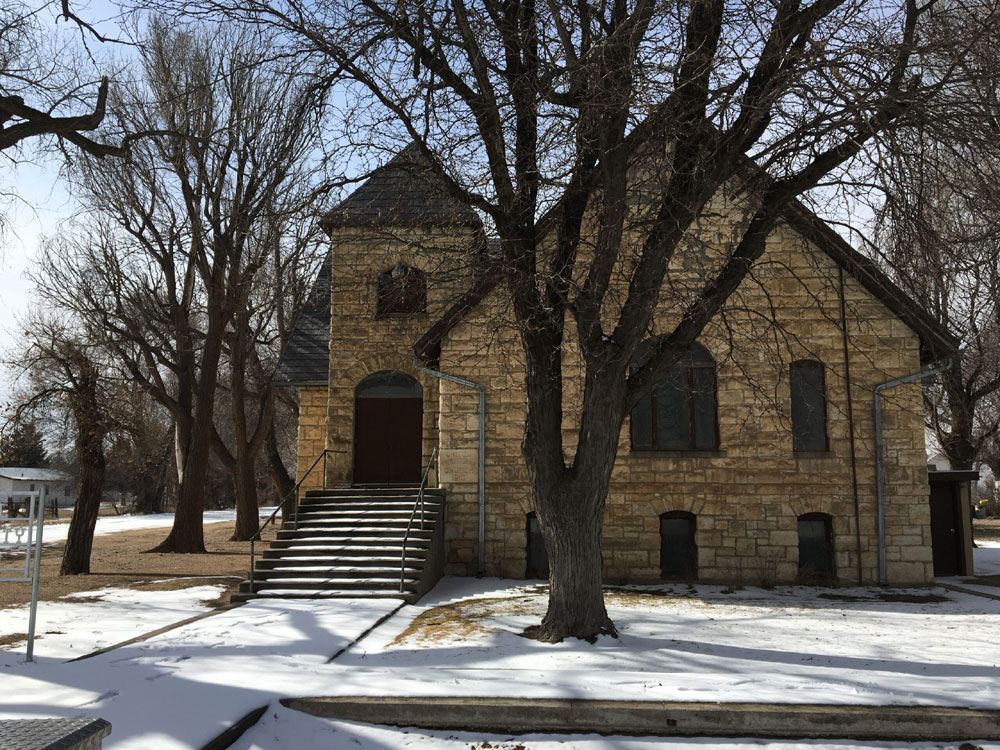

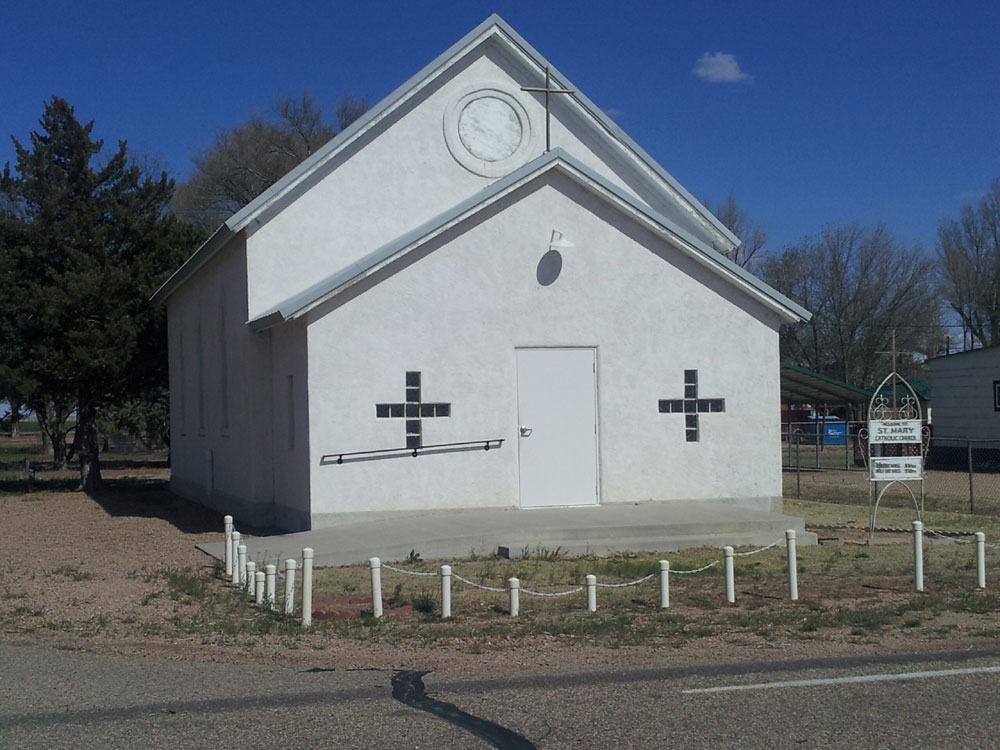
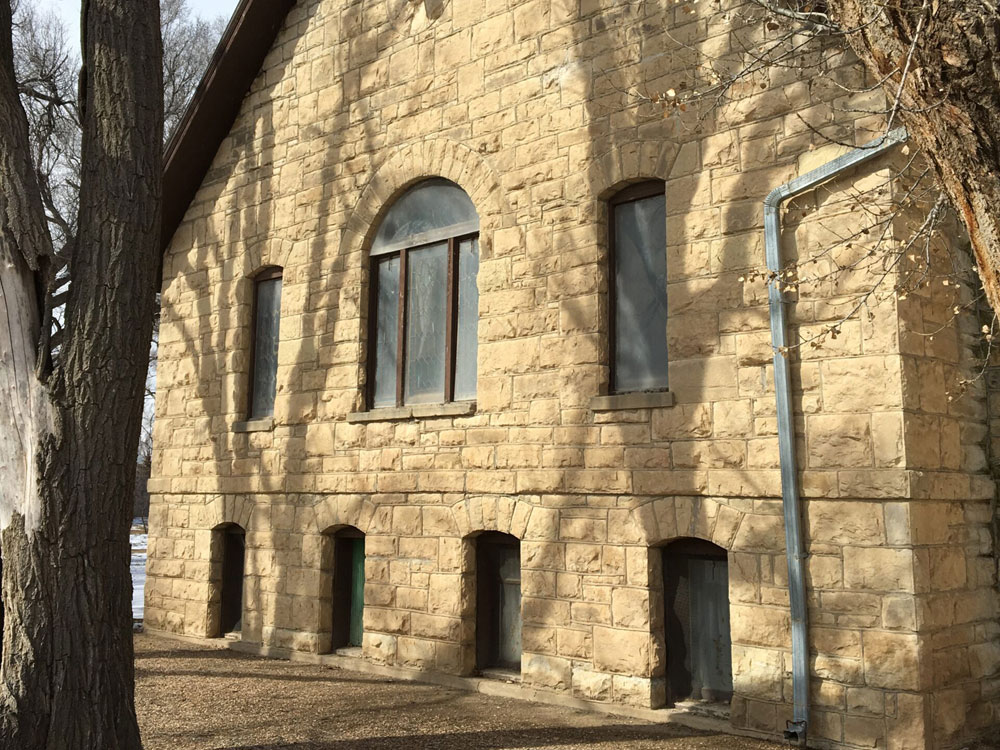
By the time the Reynolds family moved from Hartman to a farm four miles west of Bristol in 1925, the age of the automobile had been well established in Prowers County. Bristol had two school buses – one bus to take the grade school students to Bristol, and another to take the high school students to Granada. Muriel Haines, the Evans children, Arthur Gruenloh and the Stewart boys were among those sharing a bus stop with the Reynolds children to wait for the Bristol bus, driven by Cliff Warboy. When, in January of 1926, a blizzard hit the area, the school bus was unable to make the trip home and the children were taken to the Bristol Hotel for supper and then dispersed to homes in town for the night – Esther Reynolds stayed with the Warboy family. The next morning the students were taken home by lumber wagon across the fields.
Bristol area families who kept milk cows sold their extra milk to the Pet Milk Condensary in Lamar. The milk truck, driven by Steve Reish, picked milk up each morning.
Libby, McNeil and Libby Company of Manzanola furnished seed for growing pickle cucumbers and garden plots of an acre or two of farmland here and there around the countryside were given over to pickle-raising. In the Reynolds family, the children would turn out of a summer’s morning to pick pickles, putting them in a sack as they went. Then, in the late afternoon, Gladys and Lucinda Reynolds were given the job of hauling the pickles to the Bristol plant. The girls would take them in the lumber wagon hauled by a team of mules, Jerry and Beck. Each grower was given a number stamped on his sacks. Then the pickles were graded. The small pickles brought the best price, averaging a dollar per sack. The pickle-picking season lasted about six weeks each summer, and pickle-picking was a daily chore while the season lasted. The best part about the pickle business, both Ada McGee and Gladys Rink recalled, was that the company put up for each grower a large barrel of dill pickles free.
Bristol residents could claim their own movie star when the silent picture, Hands Across the Border, came to Moran’s Theater. Bert Reynolds – of the Bristol Reynolds family and not a relation to Burt Reynolds, the current movie actor – was there on the screen. The movie was made while Bert was working for Jack House in California.
Like the other towns along the Ark Valley line, Bristol’s economy suffered as railroading and local agricultural industry declined in the 1920’s. The passing of Bristol’s heyday was more abrupt and flamboyant than the other towns, however.
The first blow fell in the early morning of June 13, 1924, when the main building of the Denver Alfalfa Milling Company’s Bristol Mill burned to the ground. “Only by the desperate work of scores of volunteer fire fighters from in and around Bristol were the electric and steam power plants saved, and according to Frosty Johnson of the local office, who happened to be in Bristol at the time, the flames bid fair to eat up the whole plant. Thus far, lightning has been the only cause attributed for the calamity.” The Lamar Daily News of Friday, June 13, 1924, reported.
“At 1:00 this morning the night watchman had completed his rounds and pronounced all well, when several minutes later the fire burst forth. The Holly fire department was called, but the flames were well under control before they arrived.” F. W. Johnson was interviewed and promised the mill would be rebuilt and working within four weeks. The mill had, just a few months earlier, undergone extensive repair, and it was the renovated building which had burned.
An even more devastating fire hit Bristol a year later, when an entire block of the original business district burned on the east side of Labelle Avenue. The fire allegedly occurred on July 3, 1925, though no account of it appeared in either the Lamar Daily News or the Lamar Register for July, 1925. During that summer, however, a number of arson fires had occurred in the area, including a hay field at Hartman just a day or two before the Bristol fire.
Though the west side of the business district remained, the fire was an economic blow from which the community never recovered. Bristol, still unincorporated, remained a small convenience center for the neighboring farm community.
Courtesy of “A Prowers County History” by Ava Betz. Published by The Prowers County Historical Society, Big Timbers Museum, Lamar, Colorado, 1986.
